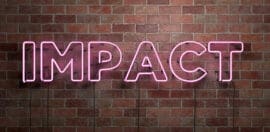The journey to measuring social impact

13 September 2021 at 5:26 pm
Mike Davis shares some of the key questions that will help guide you toward successful impact measurement.
How do you know that your organisation is having a social or environmental impact? This is the question that is at the core of impact measurement. Of course, it is very easy to “talk the talk” about social impact and adopt aggressive marketing positions based on this.
If the “talk the talk” is done before or in absence of “walking the walk”, we call this “impact-washing”. In short, this means misleading people about the size and effect of your impact in the absence of any robust impact measurement methodology or framework.
To talk authentically about your organisation’s social or environmental impact, you will need a clear roadmap that takes you from asking big questions about your organisation’s purpose to collecting the right data points and then using valid metrics to report on progress over time.
“I have been struck again and again by how important measurement is to improving the human condition.” – Bill Gates
The starting point
Organisations approach their impact measurement journey from a range of starting points, ranging from beginners, to being stuck in a rut, to being completely overwhelmed and drowning in data. Here are a few key questions that can help you identify which category you fall into:
- Beginners: What data do I need to collect, where do I get it from and how do I use it effectively?
- Stuck in a rut: I have all this great data and it has been useful, but is it helping me tell my organisation’s impact story?
- Overwhelmed: I am literally drowning in data. How do I select the right outcome and impact measures and metrics to help me tell my organisation’s best impact story?
Once you know where you are at in your impact measurement journey, you can start to consider some of the bigger questions that will help guide you toward successful impact measurement.
The 10 key questions
You can use these 10 key questions to help guide you on your impact measurement journey:
- What is your reason for measuring your impact?
- What are the outcomes and impact you’re seeking to achieve?
- Where are you at in terms of your data collection process?
- Does your existing data help you tell your impact story?
- Are there additional data sources that could help you better tell your impact story?
- What is the connection between your data and achieving positive social outcomes?
- Are you asking questions about quantity or quality?
- Who is going to help you roll out your impact measurement framework?
- How will you communicate your impact to your key stakeholders?
- Is your impact measurement framework delivering great results?
Asking these questions will help steer you on your journey to better impact measurement and reporting.
The right approaches for your audience
As with any other measurement and reporting, it is important to consider how you can best meet your audience with the right method of communication. I have written about various forms of storytelling for impact in this previous Pro Bono News article. This table may help you decide the most effective approaches for each stakeholder group:

Taking the next steps
Many of my colleagues, peers and our clients at Spark ask me if there is a simple resource that exists to assist with impact measurement.
At Spark Strategy we have developed this free handbook on how to demonstrate your impact. It is available here or via our website. We hope this helps you wherever you are at in your impact measurement journey.
“A person and an organisation must have goals, take actions to achieve those goals, gather evidence of achievement, study and reflect on the data and from that take actions again. Thus, they are in a continuous feedback spiral toward continuous improvement” – W. Edwards Deming







